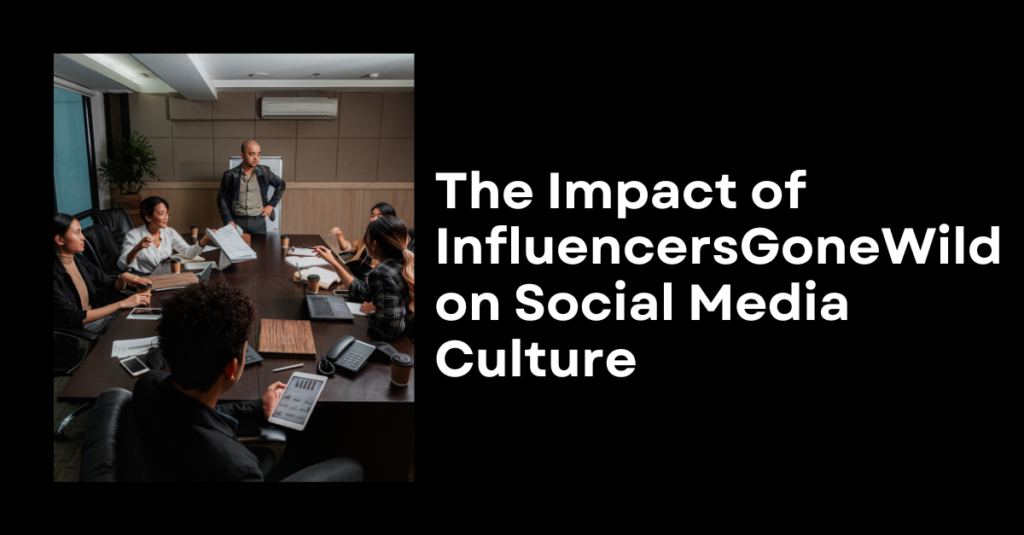In the dynamic world of social media, influencers play a key role in shaping properties, driving buyer behavior and creating cultural norms. One interesting and debatable phenomenon that has emerged in recent years is encapsulated by the time period “InfluencersGoneWild”. This time period represents a time when influencers intentionally or accidentally cross the boundaries of perfect behavior, especially with myriad consequences. In this article, we delve into the InfluencersGoneWild phenomenon, exploring its causes, notable examples, impact on the influencer industry, and wider societal implications.
Understanding InfluencersGoneWild
The term “InfluencersGoneWild” often refers to conditions where social media influencers interact in behavior that is deemed outrageous, irrelevant, or controversial. This can include anything from posting provocative or offensive material, engaging in unethical or illegal sports, to public breakdowns and disputes. Such moves routinely generate considerable public interest and regularly lead to viral moments that play out across social media systems.
The Reasons Behind the Phenomenon
Several factors contribute to the creation of InfluencersGoneWild. Understanding these underlying reasons is essential to understanding the dynamics at play:
- The pressure to stay relevant: In a highly aggressive international social media environment, influencers face a significant effort to constantly create engaging and interesting content. This tension can once in a while lead them to push the limits and take risks that they might not otherwise be aware of.
- Monetization and Sponsorship: The lucrative nature of influencer advertising can also pressure influencers to engage in questionable behavior. Provocative content often attracts greater views and engagement, which could translate into higher revenue from sponsorships and partnerships.
- Personal Struggles: Many influencers struggle with private issues, including mental health issues, substance abuse, and dating issues. These struggles may occasionally surface in public outbursts or erratic behavior, especially during InfluencersGoneWild times.
- Lack of Oversight: Unlike conventional celebrities, who often have teams of managers and publicists directing their moves, many influencers operate independently. This loss of oversight can lead to impulsive and uncalculated choices.
Notable Examples of InfluencersGoneWild
To better understand this phenomenon, let’s look at some notable examples of InfluencersGoneWild:
- Controversial Logan Paul video: In 2018, YouTube big name Logan Paul faced immense backlash after he posted a video showing a lifeless image in Japan’s Aokigahara forest, dubbed the ‘Suicide Forest’. The video became widely condemned as insensitive and disrespectful, leading to widespread public outrage and a temporary suspension of his YouTube ad revenue.
- James Charles feud with Tati Westbrook: The YouTube beauty community was rocked by the use of a general public feud between influencers James Charles and Tati Westbrook in 2019. The fallout began when Westbrook accused Charles of betrayal and irrelevant behavior, leading to a huge online drama that ended with tens of millions of subscribers lost and won, on the full-size media insurance side.
- Jake Paul’s Law-Breaking Antics: Another prominent YouTuber and influencer, Jake Paul has been involved in numerous controversies along with illegal gatherings at some stage of the COVID-19 pandemic and allegations of looting during protests. These actions brought prison troubles and widespread complaints.
- Belle Delphine’s Provocative Bits: An internet personality known for her provocative and kinky content, Belle Delphine often pushes the boundaries of appropriate behavior. From selling bathwater to creating explicit content, her movement has sparked debates about the limits of online behavior and the ethics of monetization controversy.
Impact on the Influencer Industry
The InfluencersGoneWild phenomenon has huge implications for the influencer business as a whole. While a few influencers manage to recover and even thrive after controversial incidents, others face long-term damage to their reputations and careers. Here are some key influences:
- Reputation Management: Influencers who engage in questionable behavior regularly face backlash from their audience and brands. Maintaining favorable recognition is critical to securing sponsorships and partnerships, and negative incidents can result in lost business opportunities.
- Industry Regulations: As the influencer business continues to evolve, there may be increasing pressure for extremely strict guidelines and tips. Incidents of InfluencersGoneWild highlight the need for moral requirements and responsibilities within the industry.
- Audience perception: The movements of influencers can shape public perception of a business. High-profile controversies can lead to a negative view of influencers as a whole, affecting the credibility and credibility of content creators.
- Brand Partnerships: Brands are very careful when working with influencers. The danger of associating with influencers who might also engage in controversial behavior may deter brands from partnering, mainly due to stricter vetting strategies.
Social Consequences
Beyond the on-the-ground effect in the influencer business, the InfluencersGoneWild phenomenon has wider social implications:
- Cultural influence: Influencers have a huge cultural impact, especially among younger audiences. Their behavior and movements can shape social norms and values, for better or for worse. Controversial behavior can contribute to a lifestyle full of sensationalism and superficiality.
- Mental Health Awareness: Many of the InfluencersGoneWild cases are connected to the mental health struggle. These incidents can spark vital conversations about mental health, the pressures of social media and the need for help systems for influencers.
- Public Discourse: Public discourse and media coverage are often dominated by high-profile influencer controversies. This can divert attention from extremely pressing social issues and contribute to a culture of distraction and sensationalism.
- Role Models: Influencers often act as role models for their followers. Controversial behavior can lead to poor functional modeling and potentially influence impressionable audiences to interact in similar movements.
Mitigation of the Phenomenon
Addressing the InfluencersGoneWild phenomenon requires a multifaceted approach involving influencers, structures, brands and audiences:
- Education and Support: Providing influencers with training and resources on mental health, moral behavior and reputation control can help you save time on questionable behavior. Support systems, such as the right to access mental health professionals, can also play a vital role.
- Platform Policies: Social media platforms may implement stricter rules and guidelines to discourage point behavior. This includes clearer policies on content moderation, violation outcomes, and mechanisms for reporting unsafe behavior.
- Brand Responsibility: Brands must exercise due diligence when partnering with influencers to ensure alignment with their values and moral requirements. Setting clear expectations and metrics for collaboration can help mitigate risks.
- Audience awareness: Audience plays a huge role in the influencer atmosphere. Promoting media literacy and critical thinking can enable viewers to distinguish between real and sensational content, thereby reducing the impact of controversial behaviour.
Conclusion
The InfluencersGoneWild phenomenon is a reflection of the complex and evolving social media landscape. While times of questionable behavior can garner public attention and compel engagement, they also highlight the need for greater accountability and responsibility in the influencer industry.



